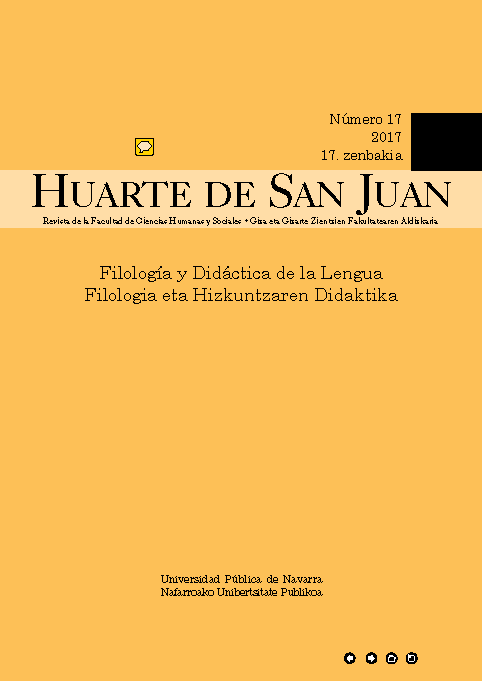Flipping the EFL classroom in a secondary education setting: Students’ perceptions and academic performance
Palabras clave:
Clase invertida, inglés como lengua extranjera, educación secundaria, aprendizaje centrado en el alumnadoResumen
Recientemente se ha popularizado un nuevo modelo de enseñanza denominado «flipped classroom» o clase invertida. Este nuevo modelo se basa en invertir la secuenciación de la clase desplazando la lección magistral fuera del aula por medio del visionado de videos en los que se explican los contenidos antes de acudir a clase. De esta manera el tiempo de clase se usa para realizar actividades más centradas en los alumnos que los involucren y que enfaticen el aprendizaje activo. A pesar de su popularidad, la investigación sobre la implementación de este modelo se ha centrado en campos basados en lecciones magistrales como ciencias, tecnología o matemáticas, y en contextos universitarios. Nuestro estudio intenta contribuir a la investigación sobre este modelo aplicándolo en una clase de inglés como lengua extranjera (ILE) en Educación Secundaria. Los resultados obtenidos mostraron mejoras en conocimientos y percepciones positivas hacia su uso para esta asignatura y en este contexto.
Descargas
Citas
Alonso, F., Lopez, G., Manrique, D. & Vines, J. (2005): «An instructional model for web-based E-learning education with a blended learning process approach», British Journal of Educational Technology, 36 (2), pp. 217-235. Doi: 10.1111/j.1467-8535.2005.00454.x
Ahmed, M. A. E. A. S. (2016): «The Effect of a Flipping Classroom on Writing Skill in English as a Foreign Language and Students’ Attitude Towards Flipping», US-China Foreign Language, 14(2), pp 98-114. Doi: 10.17265/1539-8080/2016.02.003
Anderson, L. W. & Krathwohl, D. R. (eds.) (2001): A Taxonomy for Learning, Teaching, and Assessing: A Revision of Bloom’s Taxonomy of Educational Objectives, New York, Longman.
Baepler, P., Walker, J. D. & Driessen, M. (2014): «It’s not about seat time: Blending, flipping, and efficiency in active learning classrooms», Computers and Education, 78, pp. 227-236. Doi: 10.1016/j.compedu.2014.06.006
Barreras Gómez, M. A. (2016): «Experiencia de la clase inversa en didáctica de las lenguas extranjeras», Education Siglo XXI, 34 (1), pp. 173-196. Doi: 10.6018/j/253281G
Basal, A. (2015): «The implementation of a Flipped Classroom in Foreign Language Teaching», Turkish Online Journal of Distance Education, 16 (4), pp. 28-37. Doi: 10.17718/tojde.72185
Bergmann, J. & Sams, A. (2014): «Flipped Learning. Gateway to Student Engage-ment», Learning & Leading with Technology, 41 (7) 18-23. Retrieved from: http://www.learningandleading-digital.com/learning_leading/may_2014?pg=20#pg20
Bull, G., Fester, B. & Kjellstrom, W. (2012, August): «Inventing the Flipped Classroom», Learning & Leading with Technology, 40(1), pp. 10-11. Retrieved from: http://www.learningandleading-digital.com/learning_leading/201208?pg=12#pg12
Cockrum, T. (2014): Flipping Your English Class to Reach All Learners. Strategies and Lesson Plans, London, Routledge.
Coelho, D., Galante, A. & Pires, A. L. (2016): «Online Collaboration for English Learners: Implementing and International Project with Edmodo», Teaching English as a Second or Foreign Language. The Electronic Journal for English as a Second Language,19(4), pp. 1-15. Retrieved from: http://tesl-ej.org/pdf/ej76/int.pdf
Egbert, J., Herman, D. & Lee, H. (2015): «Flipped Instruction in English Language Teacher Education: A designed based Study in a Complex, Open-ended Learn-ing Environment», Teaching English as a Second or Foreign Language. The Electronic Journal for English as a Second Language, 19 (2), pp. 1-23. Retrieved from: http://tesl-ej.org/pdf/ej74/a5.pdf.
Evseeva, A. & Solozhenko, A. (2015): «Use of Flipped Classroom Technology in Language Learning», Procedia-Social and Behavioral Sciences, 206, pp. 205-209. Doi: 10.1016/j.sbspro.2015.10.006
Hao, Y. (2016): «Middle school students’ flipped learning readiness in foreign lan-guage classrooms: Exploring its relationship with personal characteristics and individual circumstances», Computers in Human Behavior, 59, pp. 295-303. Doi: 10.1016/j.chb.2016.01.031
Hsieh, J. S. C., Wu, W.V. & Marek, M. W. (2016): «Using the flipped classroom to enhance EFL learning», Computer Assisted Language Learning, pp. 1-25. Doi: 10.1080/09588221.2015.1111910
Hung, H. T. (2015): «Flipping the classroom for English language learners to fos-ter active learning», Computer Assisted Language Learning, 28(1), pp. 81-96. Doi: 10.1080/09588221.2014.967701
Kvashnina, O. S. & Martynko, E. A. (2016): «Analyzing the Potential of Flipped Classroom in ESL Teaching», International Journal of Emerging Technologies in Learning,11 (3), pp. 71-73. Doi: 10.3991/ijet.v11i03.5309
Mazur, A. D., Brown, B. & Jacobsen, M. (2015): «Learning Designs using Flipped Classroom Instruction», Canadian Journal of Learning and Technology, 41 (2), pp. 1-26. Retrieved from: http://www.cjlt.ca/index.php/cjlt/article/view/909/421
Muldrow, K. (2013, November): «A New Approach to Language Instruction – Flipping the Classroom», The Language Educator, pp. 28-31. Retrieved from: https://www.actfl.org/sites/default/files/pdfs/TLE_pdf/TLE_Nov13_Article.pdf
Prefume, Y. E. (2015): Exploring a Flipped Classroom Approach in Japanese Lan-guage Classroom: A Mixed Methods Study (Doctoral dissertation, Baylor University, Texas, USA). Retrieved from: https://baylor-ir.tdl.org/baylor-ir/bitstream/handle/2104/9569/PREFUME-DISSERTATION-2015.pdf?sequence=1&isAl-lowed=y
Toto, R. & Nguyen H. (2009): «Flipping the work design in an industrial engineering course», Proceedings, 39th ASEE/IEEE Frontiers in Education Conference, San Antonio, Texas, USA, pp. 1-4. Doi: 10.1109/FIE.2009.5350529.
Tucker, B. (2012): «The Flipped Classroom. Online instruction at home frees class time for learning», Education Next. 12(1). Retrieved from: http://educationnext.org/files/ednext_20121_BTucker.pdf.
Wong, K. & Chu, D. W. K. (2014): «Is the Flipped Classroom Model Effective in the Perspectives of Students’ Perceptions and Benefits?», in Cheung, S. K. S., Fong, J., Zhang, J., Kwan, R., Kwok, L. F. (eds.), Hybrid Learning. Theory and Practice, Shanghai, Springer, pp. 93-104.
Descargas
Publicado
Cómo citar
Número
Sección
Licencia
Todos los artículos son publicados bajo una licencia de uso y distribución Creative Commons (BY-NC-ND 4.0). A cada artículo se le asignará un identificador DOI.
Los autores conservan los derechos de autor y conceden a la revista el derecho de la primera publicación. Los autores podrán establecer acuerdos adicionales para la distribución no exclusiva de la versión de la obra publicada en la revista (por ejemplo, situarlo en un repositorio institucional), con un reconocimiento de su publicación inicial en esta revista. Los trabajos podrán subirse a repositorios institucionales inmediatamente tras la publicación de la revista.
Asimismo, se permite y se anima a los autores a difundir sus trabajos electrónicamente (por ejemplo, en repositorios institucionales, redes sociales académicas o en su propio sitio web).







